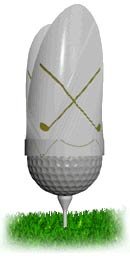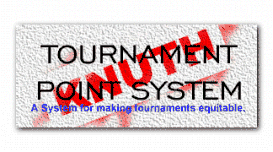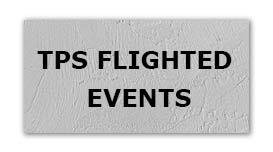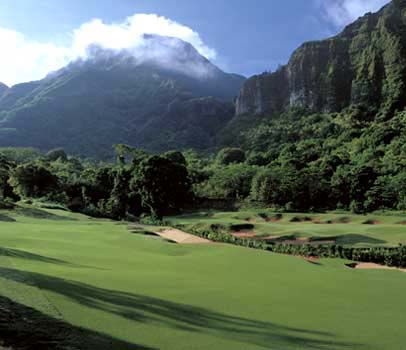GOLF LEGEND: The course at Ko'olau Golf Club has a slope rating of 162 (where the maximum slope rating is 155).
STATUS: False, but Once Basically True.
In what is likely the most famous scene in the classic 1984 comedy, This is Spinal Tap, the director of the "mockumentary" about a fictional rock band, Marty DiBergi (played by Rob Reiner, who did, indeed, direct the film), is given a tour of the stage equipment of Spinal Tap lead guitarist Nigel Tufnel (played by Christopher Guest). Tufnel is especially proud of his Marshall guitar amplifiers, whose volume level have eleven as the highest setting instead of ten (typically, amplifier sound levels are set as zero to ten), believing that his amplifiers having eleven as the highest level means that his amplifiers are louder than all others ("it's one louder"). When DiBergi asks him, "Why don't you just make ten louder and make ten be the top number and make that a little louder?" Tufnel has no idea what he is trying to get at, repeating again that these amps go up to eleven.
I am reminded of this famous scene when the course at Hawaii's famed (or perhaps infamous?) Ko'olau Golf Club is discussed. If you consult almost any guide to golf courses of the world, you will find a consistent description of this dramatic course. You see, the golf course, which was carved out of rain forest on the windward side of the Ko'olau Ridge mountain ridge on the eastern side of the island of Oahu, and contains winding ravines as the target for holes, incredible and dramatic elevation changes and huge sand bunkers is: "[c]onsidered the toughest course in the nation from the back tees with a slope rating of 162."
This is especially remarkable since the highest slope rating theoretically possible is 155.
So what's the true story behind Ko'olau Golf Course's amazing slope rating? And what, exactly, is a "slope rating?" Read on to find out!
When it comes to determining the difficulty of golf courses, there are two notable rating systems used, both developed (and measured) by the United States Golf Association (USGA). One is called course rating and the other is called slope rating.
Before determining course rating, let us define two terms - a "scratch golfer" and a "bogey golfer." A scratch golfer is defined by the USGA as a male golfer who hits his drive 250 yards and can reach a 470-yard hole in two; or a female golfer who hits her drives 210 yards and can reach a 400-yard hole in two. A bogey golfer is defined by the USGA as a male golfer with a handicap index of 17.5 to 22.4 (that is, he will be estimated to shoot 17.5 to 22.4 shots over par on any given golf course), who hits his drives 200 yards and can reach a 370-yard hole in two; and a female golfer with a handicap index of 21.5 to 26.4, who hits her drives 150 yards and can reach a 280-yard hole in two.
The USGA's rating agents then examine the golf course based on both groups of players. Let us say that a particular hole is 450 yards away from the tee. So the rating agents will travel 250 yards from the tee and examine the situation (and, similarly, for bogey golfers, they'll travel 200 yards). What does it look like? What is the distance to the green? Are there obstacles in the way? What angle is there to the green? Where are the trees around the area? How tall are the trees? As you might imagine, there are a whole lot of different things to consider when making a rating. Then the course as a whole is taken into consideration. Are there downslopes? Upslopes? Lots of bunkers? Not a lot of bunkers? Crazy difficult bunkers? Ultimately, though, they will assign a course rating for both a scratch golfer and a bogey golfer, which will be represented in how many shots each particular golfer would be estimated to require to complete the course (one number for male scratch golfers, one for male bogey golfers, one for female scratch golfers and one for female bogey golfers).
There is no set average course rating for scratch golfers, although 72 or 73 seems to be about right. Do note that this, of course, depends on which tee you use - the standard tee or the "back tee," where you hit from a tee further back (which naturally makes the course, and the course rating, much harder).
So if that's the course rating, what is a "slope rating?"
The term is a bit misleading, since golf courses often have slopes (and some have particularly difficult ones), it suggests that that is what the "slope" in the name measures. In actuality, slope rating measures the relative difficulty of a golf course for bogey golfers. As I mentioned before, the rating agents will test how many shots they estimate a scratch golfer will need to complete a course and they will also test how many shots a bogey golfer will need to complete the same course. The "course rating" is based on the scratch golfer's score. The "slope rating" is based on a comparison between the bogey golfer's score and the scratch golfer's score. The term arises because an interesting thing was discovered when the USGA began rating golf courses - the more difficult the course, the greater the discrepancy was between scratch and bogey golfers. Logically, you would think that if a golfer typically needed five more shots to finish a course than another golfer, then if they played a difficult course, that would be the same. The better golfer would finish it in X shots and the worse golfer would finish it in X plus five shots. However, the USGA discovered that on really difficult courses, the shots needed by bogey golfers were NOT proportional to the shots needed by scratch golfers. Instead, they would need a good deal more shots than expected. If you plotted the expected number of shots needed, it would look like a straight line. If you plotted the actual number of shots needed, it would look like a steep incline, or a "slope," hence the term "slope rating."
Slope rating is determined by subtracting the scratch course rating from the bogey course rating and multiplying it by 5.381 for men and 4.24 for women. The theoretical minimum Slope Rating would be a 55 (the easiest course for bogey players) and the maximum would be 155 (for the hardest). The average slope rating is 113. Again, though, this was all theoretical, based on the data collected by the USGA over the years. It was not theoretically possible for a bogey golfer to exceed 1.55 strokes from a scratch golfer, and this certainly appeared accurate in the years after Dean Knuth introduced the Slope Rating for USGA in 1982.
However, in 1992, when the Ko'olau Golf Club opened up its course, legends began to spring up about the difficulty of the course. The first time that former U.S. Open champion Scott Simpson played the course, he shot 80. Chi Chi Rodriguez shot an 88 on his first attempt at the course! And neither Simpson nor Rodriguez was playing from the back tees!
Initially, the USGA gave the course a 152 slope rating from the back tees. This amazed Knuth (the inventor of the Slope Rating) so he went to investigate, and he determined that 152 did not seem high enough!!
A few years later, a rating team from the USGA came by and made basic estimates that established an astonishing 162 slope rating for the course from the back tees, which matched what Knuth estimated himself during his visit.
However, for whatever reason (perhaps sheer incredulity?), this 162 was never made the official rating by the USGA and since then, the course has made some changes to clear up the areas around the fairway, and 152 is the official Slope Rating for the back tees at Ko'olau. You can find as much at the official website of the course, which describes it as such (emphasis added):
Carved out of a magnificent tropical rain forest on the windward side of the 2,000-foot Ko'olau Ridge mountain range, Ko'olau encompasses three distinct climate zones and features winding ravines, extreme elevation changes, and breathtaking views of cascading waterfalls. Situated on eastern Oahu, the rugged landscape of this tropical jungle course uses ravines as the target for holes and boasts lush vegetation and huge sand bunkers. Considered the toughest course in the nation from the back tees with a slope rating of 152, Ko'olau's spectacular setting will inspire you from beginning to end.
Whether it ever actually reached an eleven out of ten, Ko�olau still sounds like an amazing course!
Thanks to Dean Knuth and his wonderful website, The Pope of Slope, for much of the information about Slope Rating over the years, and thanks to the Ko'olau Golf Club for their official stance on the Slope Rating.
--Brian Cronin
Photo: The course at Ko'olau Golf Club. Credit: Associated Press.









